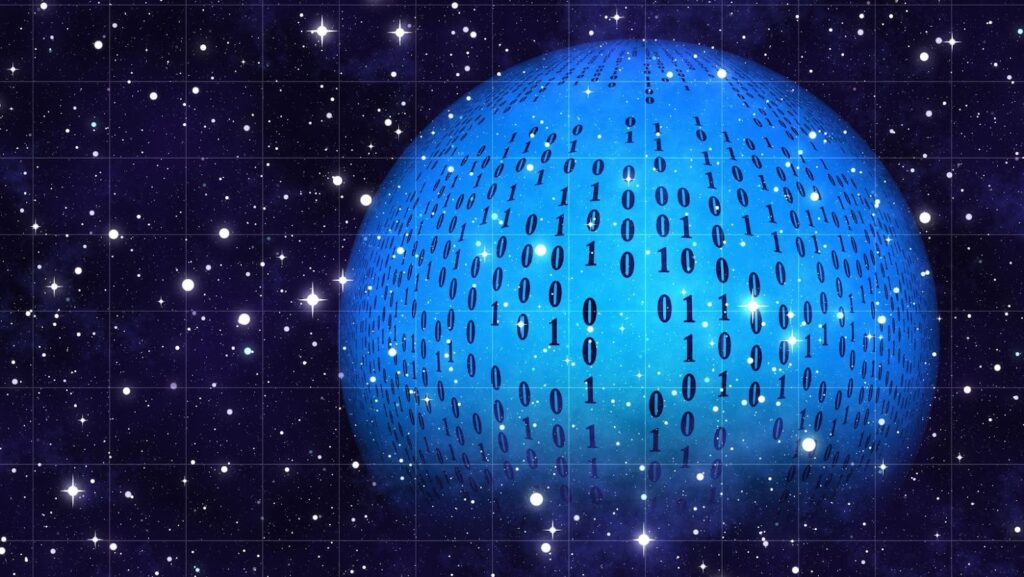Nvidia’s plans for the Omniverse are revolutionary. In short, the Omniverse is a virtual platform that enables advanced collaboration between virtual and physical environments.
This powerful platform is filled with applications and features that can benefit users.
In this article, we will explore the capabilities and benefits of the Omniverse in more detail.
Definition of the Omniverse
Nvidia’s Omniverse is a powerful and ambitious simulation platform that seeks to bring the physical and virtual worlds together. Omniverse aims to create a comprehensive digital twin of our planet, fostering collaboration between individuals from different disciplines, cultures, and organizations.
The Omniverse seeks to bridge the gap between different design systems by providing individuals or teams worldwide access to a shared virtual environment. By leveraging technologies like photogrammetry and machine learning, developers can capture real-world objects and environments in unprecedented detail. This allows for much more realistic simulations than ever before.
On top of the breathtaking visuals powered by Nvidia’s RTX graphics cards like their new RTX 2080 Ti GPUs, the Omniverse will also feature physics simulation capabilities so that various activities can be simulated in real time without special programming languages or manual coding necessary. From complex architectural designs that move with the wind’s force to soft-body simulations involving millions of particles, almost anything can be modelled and tested using Nvidia’s tools within the Omniverse ecosystem.
Furthermore, many tools available through the platform are completely open source so users will have total control over what they can do with simulation results while taking advantage of modern cloud computing technology through GPU clusters available through Amazon Web Services (AWS). With these tools combined, it’ll eventually be possible for teams worldwide to collaborate in ways never imagined.
What it is and why it matters
The Nvidia Omniverse is a software platform developed by Nvidia to allow users to simulate, collaborate and create 3D content in real time. It is intended to enable re-use of assets across several disciplines and applications, such as engineering, media design and photography. The platforms provides access to an ecosystem of tools, data formats, computer engines and content from many different sources simultaneously, allowing users to give life to their ideas more quickly.

Nvidia’s plans for the Omniverse are based on bringing together a wide range of developers who will form part of the growing community of content creators that harnesses the potential of powerful GPUs. This allows users worldwide to effectively communicate more quickly and collaborate more efficiently. In addition, with its ability to render powerful GPU simulations in real time , the Omniverse helps professionals create realistic 3D animations that can be shared in stunning detail with everyone involved in the project, no matter where they are located.
The use of advanced physics-based rendering techniques, combined with NVIDIA RTX technology brings processing power that much closer to photorealism than ever before – something current CGI tools cannot achieve without an immense amount of effort from an artist or programmer. Furthermore it enables higher levels of collaboration amongst creative professionals who use it, allowing them to improve workflow efficiency throughout any given production pipeline thanks to its temporal organisation capabilities for complex projects.. The platform also benefits end users via web APIs. It allows simpler interactions across distributed teams, allowing them to instantly share their workflows without worrying about long manual transfer times or performance bottlenecks across artistic crew members machines.
Nvidia’s Plans for the Omniverse
Nvidia’s recent plans for the Omniverse involve creating a virtual universe of objects, shared across multiple applications. This could allow for real-time collaboration, simulation and design for enterprises, allowing them to break down traditional barriers between teams and applications.
Let us dive further into Nvidia’s plans for the Omniverse, and discuss the potential benefits of this new technology.
Overview of Nvidia’s plans
The Omniverse is a revolutionary new platform created by tech giant Nvidia that offers the power of real-time collaboration and simulation across multiple disciplines, allowing creative professionals to interactively collaborate on 3D models, animations and game levels. The Omniverse can also be used as an environment for research, development, and training for robotics or virtual reality applications. It also supports collaboration across different industries such as film, games, industrial design, architecture, engineering, etc.
Nvidia plans to leverage the power of its frequently updated hardware to set AMD hardware apart from other models in terms of the speed of their renderings. They have released their first update to their RTX RTX 3090 GPU, which sports 36 GB DDR6 RAM with a stunning 93 TeraFLOPs compute performance compared with its predecessor. This makes it one of the fastest GPUs for rendering applications in Omniverse simulations.

Additionally, Nvidia has released a new software platform known as RTX IO which is designed to allow developers to take advantage of NVIDIA’s I/O (input/output) features such as Direct Memory Access (DMA) transfers and low-level APIs that grant computational access privileges. This provides faster transfer speed and better control over memory mapping than what has been available before; enabling professionals to access large datasets and render simulations at unprecedented speeds.
Nvidia continues innovating their platforms while they continue developing tools that expand not only gaming but also more professional workflows like engineering exploration or architectural visualization through shared live VR experiences provided by companies like Autodesk’s Stingray engine or Sketchfab’s Universal Viewer Pro 3D content viewer service and also through interactive data visualization environments like Clarisse iFX from Isotropix for example. As these technologies continue advancing, we expect Nvidia’s plans for the Omniverse will bring this AI-accelerated ecosystem into even sharper focus.
Benefits of the Omniverse
Nvidia’s plans for the Omniverse, its 3D simulation platform, are focused on creating an experience allowing users to collaborate across various virtual worlds. This platform promises to blur physical and virtual reality boundaries, creating a more immersive experience.
The Omniverse enables real-time collaboration between applications, such as 3D design, animation, and production. With this platform in place, teams can be brought together across various platforms in a single virtual world. This makes it easier for artists to work on projects together without sending assets back and forth across different applications or platforms.
Aside from its ability to facilitate cross-platform collaborations in real-time, some of the most notable benefits of the Omniverse include shortened iteration times for feature development, greater consistency between applications used in production processes and improved sharing of assets among peers. By using its distributed computing capabilities, teams can perform performance-intensive tasks faster than ever. In addition, the implementation of multithreaded rendering allows tasks to be broken down into multiple threads that run parallel for maximum efficiency and performance.
Overall, Nvidia has allowed stakeholders from different industries to collaborate effectively and efficiently when building new experiences or sharing designs with colleagues. With its suite of features specifically tailored towards enhancing productivity in large teams working together on complex projects over multiple application versions or platforms — the Omniverse is a true game changer that will open new possibilities when creating digital worlds remotely.
How the Omniverse Works
Nvidia recently announced their plans for the Omniverse, their ambitious new open collaboration platform. The Omniverse aims to open the door to unlimited exploration and collaboration of 3D applications from any device.
It works by connecting multiple applications, users, and hardware platforms. In this article, we’ll look at how the omniverse works and explore some of its key benefits.
Overview of the architecture
Nvidia developed the Omniverse collaboration platform to allow people to collaborate and create content across a digital space. It combines computer-generated elements with real-world simulations to produce realistic 3D models. This platform uses advanced algorithms and artificial intelligence (AI) to create lifelike environments, presentations, and more.
The architecture of the Omniverse is based on a client/server model, allowing users to access the platform remotely from any device with an internet connection. The current version of the Omniverse includes client applications for Windows and Chrome, as well as a web-based interface for Android devices and Apple devices. The server side of the architecture contains cloud services such as Amazon Web Services (AWS), Microsoft Azure, Google Cloud Platform (GCP), IBM Cloud Platform (IBM CP), Oracle Cloud Platform (OCP), and OpenStack.
Applications on the Omniverse include virtual reality (VR) and augmented reality (AR). These applications allow users to manipulate objects in real time in collaborative workspaces using physical controllers, contours or hand gestures. With its powerful AI capabilities, the platform can enable dynamic scenes that can be customized or saved for future use. Additionally, it enables users to collaborate with anyone regardless of their geographic location or skill level.
In addition, Nvidia’s plans for the Omniverse aim to provide users with access to easily transferable 3D assets to move existing content into their workspaces without any additional coding experience required.
How it enables collaboration
Nvidia’s plans for the Omniverse have the potential to revolutionize collaboration across a variety of platforms. Through the power of Omniverse, teams can work on projects together by weaving together virtual worlds hosted in different applications, operating systems, and hardware environments.

It also allows members to upload or download assets between different Team projects and manipulate them in multiple ways — VR, AR, 3d imagery, video effects — without switching between different programs, applications or workflows. This means that teams can now collaborate more freely than ever before on any kind of project imaginable.
Another benefit is that teams using the Omniverse can build more efficient pipelines and avoid costly errors due to incompatibilities between team members and tools. Furthermore, NVIDIA’s real-time performance engine will aid in enabling fast rendering even when running on high complexity projects such as photorealistic visual effects and simulations.
The result is a more productive environment where creative ideas can flow unrestricted by any technical barriers or compatibility issues which has been a hurdle for many collaborative efforts in the past. Nvidia’s vision for the Omniverse will drive innovation in 3D animation and development once they launch it in 2021 – so watch this space!
Applications of the Omniverse
Nvidia’s Omniverse is an open ecosystem for simulation and collaboration platform that can be integrated with computer-aided design (CAD) tools. It is designed to help users create and collaborate on immersive 3D worlds and models in real time.
In this section, we’ll explore the various applications of the Omniverse, from creating virtual reality (VR) experiences to providing a platform for industrial design and 3D printing.
Overview of the potential applications
The potential applications of Nvidia’s Omniverse platform are exciting and vast. The Omniverse is a collaborative 3D simulation platform, combining the power of data-driven artificial intelligence and virtual reality with Nvidia’s gaming and graphic visualization technology. It enables organizations to experience a world where teams from anywhere can work together to build, design, develop and interact with 3D content — anytime, anywhere.
Using the cloud-based platform, teams of professionals can access the same 3D environment in real-time to collaborate on projects seamlessly. This allows for the development of complex simulations or rapid prototyping; allowing them to experience physical projects as if they were in reality. Furthermore, it combines machine learning (ML) technology with high performance graphics rendering on NVIDIA GPUs to drive innovation in true-to-life simulations built specifically for training applications like self-driving cars or humanoid robots.
Moreover, with its world building capability, the Omniverse can help eliminate costly research efforts while enabling teams across disparate locations to leverage powerful tools such as augmented reality (AR) or digital twins – replications of physical products – increasing productivity significantly throughout their processes.
In terms of industry use cases, this open collaboration platform could be applied to a variety of industries like automotive where designers may now interactively develop car prototypes before rolling them out into production at scale; entertainment where filmmakers could create real-time visual effects; medical science where surgeons could simulate operations before undertaking them; architecture & construction where architects could build virtual blueprints that evolve; robotics & automation for autonomous machines; aerospace for engineering simulation of new aircrafts or spacecrafts etc. Consequently with all these benefits, Nvidia’s Omniverse stands ready and poised to revolutionize many industries by taking simulated collaboration to a whole new level!
Examples of current and future applications
Nvidia’s plans for the Omniverse include applications for an expanding range of industries, from healthcare to aerospace and defence. Some examples of current and future applications in these sectors are outlined as follows:
Healthcare: The Omniverse can simulate emergent situations in medical scenarios and facilitate remote collaboration between professionals in different hospitals or countries. It can enable healthcare providers to better understand anatomical systems and share their insights with colleagues.
Aerospace: The Omniverse enables simulation-based design for the aerospace industry, enabling engineers to collaborate more easily on complex projects by sharing their work in real-time in a virtual environment. This will enable faster development of new aircrafts across the globe with minimum disruptions due to global airflow regulations or local logistics challenges.
Defence: Artificial Intelligence (AI) is a core technology driving many defence programmes, particularly those requiring simulations involving high levels of complexity, such as next-generation weapons systems or autonomous navigation capabilities. The Omniverse provides an ideal platform for rapidly building AI training sets which can be shared across multiple defence contractors simultaneously without compromising security.
Conclusion
Nvidia’s Omniverse promises to be an incredibly comprehensive and versatile platform for developers in the future. With its formidable 3D simulation capabilities, collaboration capabilities, and its natural language processing, the Omniverse could be the backbone of the future of development.
We’ve outlined the various capabilities of the Omniverse and its potential implications for the future. Let’s wrap up by summarizing the key benefits of the Omniverse.
Summary of the Omniverse
Nvidia’s plans for the Omniverse platform revolve around building a fully integrated real-time interactive virtual universe. Using its RTX-based GPUs, they intend to create an environment where creators from all industries can collaborate on projects without geographical boundaries. This would enable various applications such as game development, product design, educational experiences, and cinematics.
The platform will allow users to access powerful custom-tailored rendering tools and libraries for specific industry requirements. It will also provide secure environments with user authentication, copyright protection and data integrity features implemented at all system architecture layers. NVIDIA is also developing a secure digital ledger technology on top of the Omniverse platform which will facilitate collaboration in a peer-to-peer manner by allowing creators to store their work productively and accurately and easily find and collaborate with others from around the world.


More Stories
Reasons Why Instagram is Essential for Building Your Personal Brand
Comprehensive Assessment of Dafabet Sportsbook
How Smart Contract Audits Build Trust in Blockchain Applications